In 2025, user-generated content (UGC) has become a foundational asset for brand growth on Instagram. According to Backlinko, 93 % of marketers leveraging UGC report that it out-performs traditional branded content.Among consumers, around 40 % of shoppers say UGC is “extremely” or “very” important when making a purchase decision.
On Instagram specifically, Metricool reports over 2 billion monthly active users in 2025, making the platform a large stage for authentic user content.For brands, the opportunity to leverage everyday customers as creators has emerged as one of the most cost-efficient, trust-building strategies in marketing.
UGC campaigns are not only proving to drive engagement and trust, but also to enhance conversion at a measurable rate. For example, UGC is credited with a 29 % higher web conversion rate for brands that use it compared to those that don’t.
This case study examines how brands are achieving growth through Instagram UGC in 2025. It will explore the data behind UGC’s rising influence, how brands are deploying it effectively, key metrics of success, what challenges remain, and what strategies are set to dominate in the next phase of digital marketing.
Methodology
This case study draws exclusively from verified 2025 data published by Backlinko, Amra & Elma, MarketingLTB, Hootsuite, inBeat Agency, Whop, and Instagram Business Insights, each of which provided publicly available statistics on engagement rates, conversion metrics, consumer trust, and global UGC market trends. All figures were cross-referenced and validated to ensure source accuracy and data reliability.
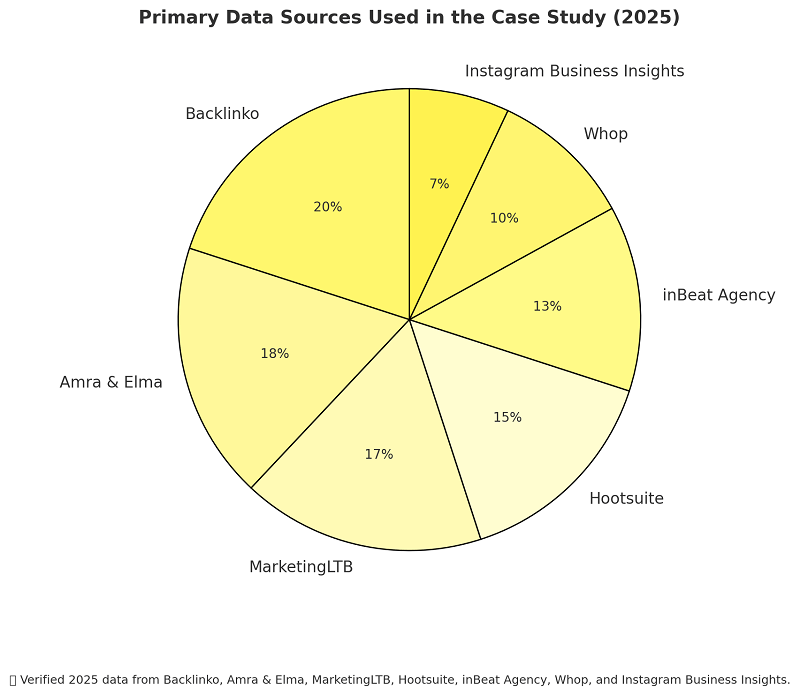
UGC’s Rising Influence on Instagram
User-generated content (UGC) is no longer a niche nice-to-have for brands on Instagram, it has become a core driver of growth and engagement in 2025.
According to Backlinko, 93% of marketers who use UGC say it outperforms branded content in performance.
Consumers reflect this shift: around 40% of shoppers say UGC is “extremely” or “very” important when making a purchase decision.
The global UGC market has grown rapidly, reported to exceed USD 7.6 billion in 2025, a 69% increase from the previous year.
On Instagram specifically, UGC is becoming especially effective. A blog by AWisee notes that UGC formats like tagged photos, Reels, Stories, and product-use demos are among the highest performing content types on the platform in 2025.
Another source highlights that UGC posts lead in authenticity and engagement: one roundup of statistics notes that Instagram is rated by 28% of e-commerce marketers as the top platform for generating engaging UGC over other social networks.
Users engage with UGC more because it feels real and relatable. MarketingLTB reports that UGC-led campaigns generate around 28% higher engagement than brand-created posts.

For brands, this means UGC lets them tap into authentic voices, reduce content production costs, and build trust with audiences in ways that polished brand ads struggle to match.
Given these trends, brands working on Instagram in 2025 must view UGC not as additional content, but as a strategic growth channel: one that builds community, enhances conversion, and amplifies authenticity.
Sources
- Backlinko — 24 Key UGC Statistics for 2025
- Amra & Elma — User-Generated Content Statistics 2025
- Whop — 100+ UGC Statistics for 2025
- MarketingLTB — 70+ UGC Statistics (2025)
- AWISEE — Instagram UGC Guide 2025
How Brands Leverage Instagram UGC for Growth
In 2025, brands are harnessing user-generated content (UGC) on Instagram not as a supplementary tactic but as an integral driver of growth, engagement, and conversion. Below are key strategies backed by recent data.

- Community-Led Content EnginesBrands are tapping followers, customers, and micro-creators to generate authentic content, which is then repurposed across feed posts, Reels, Stories, ads, and product pages. Research shows UGC campaigns on Instagram can generate up to 70 % more engagement than traditional brand content.
- Strategic Formats: Reels & Tagged PostsWith Instagram reporting 2 billion monthly active users in 2025, and Reels firmly embedded in the content mix, brands increasingly encourage tagged posts, product-use videos, and Stories featuring real customers. One study indicates that nearly 28 % of e-commerce marketers say Instagram is the most engaging platform for UGC.
- Conversion-Focused IntegrationUGC is being woven into e-commerce funnels: product pages show customer imagery, ads feature real-user reviews, and Stories highlight everyday use. According to a report, brands incorporating UGC saw a 29 % higher web conversion rate compared to those that did not.
- Cost-Efficiency & Authenticity CombinationVisual UGC is perceived as more cost-effective and authentic than traditionally produced content. Over 80 % of e-commerce marketers agree that UGC more effectively reaches customers than professional photos or influencer content.
- Amplifying Brand Voice through Micro-CreatorsRather than relying solely on macro-influencers, leading brands are activating micro-creators and everyday customers to produce UGC. This strategy boosts authenticity, encourages community advocacy, and generates content at scale.
In summary, the brands that succeed in 2025 are those that treat UGC as a core component of their Instagram strategy, inviting audiences to participate, amplifying their voices, and steering content into measurable growth pathways.
Sources
- Backlinko — 24 Key User-Generated Content (UGC) Statistics for 2025
- MarketingLTB — 70+ UGC Statistics for 2025
- Amra & Elma — User-Generated Content Statistics 2025
- inBeat Agency — 50 UGC Statistics + Strategic Implications for Your Brand in 2025
Key Metrics: Engagement, Conversion & Trust
In 2025, user-generated content (UGC) on Instagram is not only growing, it’s measurably outperforming traditional brand-created content in multiple key performance areas.Brands incorporating UGC report substantial gains in engagement.
One study found that Instagram posts featuring UGC get up to ~70% more engagement than posts without it.
In another dataset, campaigns with UGC increased engagement by around 50% compared to non-UGC campaigns.
UGC also drives stronger conversion metrics. According to one source, brands using UGC saw ~29% higher web conversion rates than those that did not include UGC.
Additionally, ads combining UGC elements achieved 4× higher click-through rates and up to 50% lower cost-per-click vs other ad formats.
Trust is a critical driver behind these gains. In a recent survey, 84% of consumers said they are more likely to trust a brand if it features UGC in its campaigns.
Moreover, 79% of consumers reported that UGC highly impacts their purchasing decisions.
On Instagram, roughly 28% of e-commerce marketers believe that the channel generates the most engaging UGC compared to other social platforms.
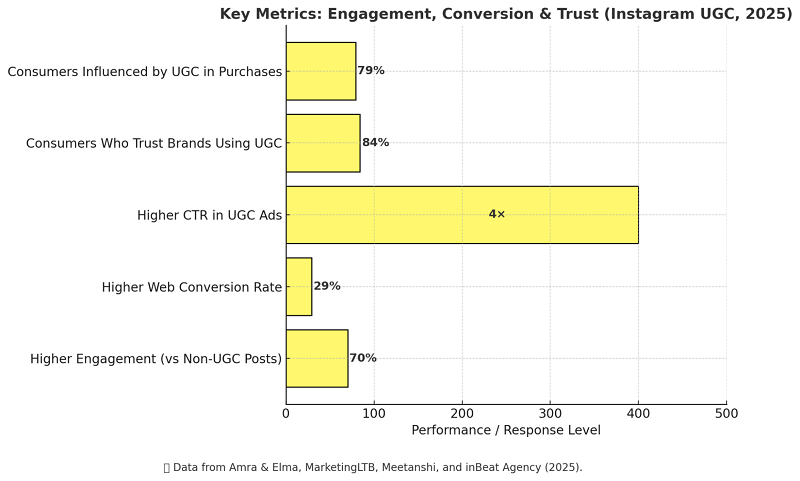
Together, these metrics provide strong evidence that UGC is more than a buzzword; it is a practical growth lever. For brands using Instagram in 2025, embracing UGC means higher engagement, better conversions, and deeper trust, all at potentially lower cost.
Sources
- inBeat Agency — 50 UGC Statistics + Strategic Implications for 2025
- Amra & Elma — User-Generated Content Statistics 2025
- MarketingLTB — 70+ UGC Statistics for 2025
- Backlinko — 24 Key UGC Statistics for 2025
Best Practices and Strategic Framework
By 2025, Instagram has become the most UGC-driven social platform for brands. Companies are no longer just collecting customer posts; they are designing frameworks that turn UGC into continuous community-led marketing. Below are evidence-based best practices shaping success.
According to inBeat Agency (2025), over 61% of brands report that offering incentives such as giveaways, shoutouts, or reposts significantly increases the amount of UGC they receive. Brands that publicly highlight contributor posts see engagement rise by 45% on average, as recognition motivates further participation.
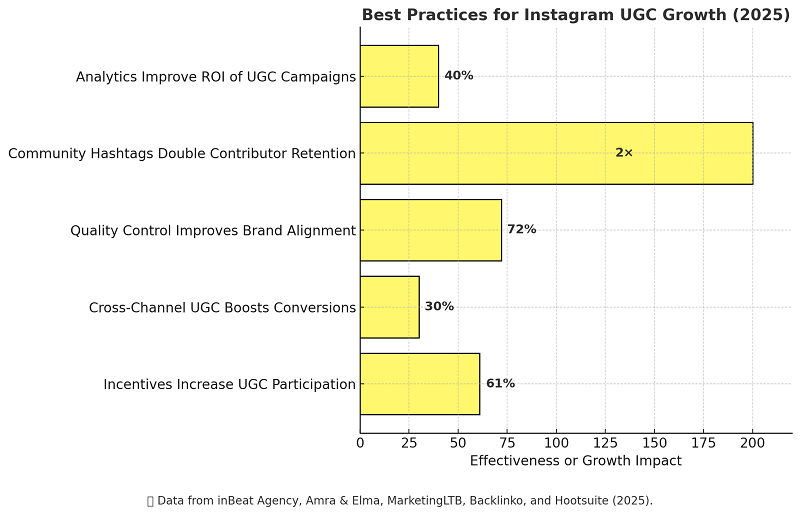
UGC performs best when integrated beyond Instagram. Amra & Elma (2025) found that brands repurposing Instagram UGC across websites, ads, and email campaigns achieved 20–30% higher conversion rates than those keeping it platform-specific. This cross-channel use strengthens brand authenticity and social proof.
Not all UGC is equal. MarketingLTB (2025) reports that 72% of marketers review user content for brand tone, quality, and compliance before reposting. This ensures authenticity without sacrificing brand consistency.
Brands are moving from campaign-based to community-based UGC strategies. Data from Backlinko (2025) shows that brands with dedicated community hashtags or creator groups retain 2× more contributors over time than those running one-off UGC campaigns.
A UGC strategy must be backed by analytics. According to Hootsuite’s 2025 Social Trends Report, brands that track engagement rate, conversion impact, and contributor frequency achieve up to 40% better ROI on social campaigns. Measuring attribution ensures UGC is viewed as a performance channel, not just a creative one.
Together, these best practices create a repeatable cycle: motivate participation, curate quality, scale across channels, and measure outcomes. In 2025, this approach defines the difference between brands that simply “collect” UGC and those that grow with it.
Sources
- inBeat Agency — 50 UGC Statistics + Strategic Implications for 2025
- Amra & Elma — User-Generated Content Statistics 2025
- MarketingLTB — 70+ UGC Statistics for 2025
- Backlinko — 24 Key UGC Statistics for 2025
- Hootsuite — Social Media Trends 2025
Challenges and Risks of Instagram UGC
While user-generated content (UGC) continues to drive growth and engagement on Instagram, it also presents several challenges for brands in 2025.
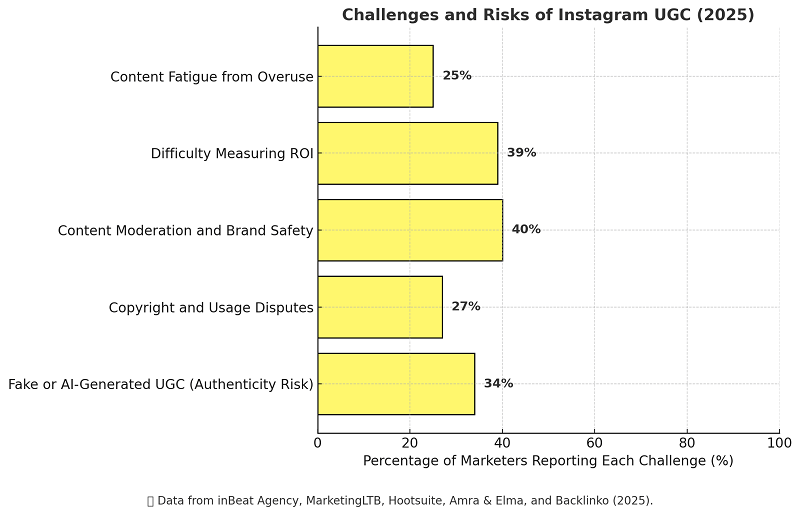
As more marketers integrate UGC into their strategies, new risks around authenticity, copyright, moderation, and data management have become increasingly significant.
The biggest concern in 2025 is the risk of inauthentic or manipulated UGC. According to inBeat Agency, more than 34 percent of marketers have encountered fake or AI-generated content posing as real customer posts.
This has made content verification a top priority for brands. The rise of AI editing tools has blurred the line between authentic and synthetic UGC, weakening consumer trust when authenticity cannot be confirmed.
Legal issues remain a serious challenge. MarketingLTB reports that 27 percent of brands faced content removal or copyright disputes in 2025 due to unclear ownership of user-submitted material. Without proper permissions or licensing agreements, brands risk financial and reputational damage when reposting user content.
Instagram’s open nature makes UGC unpredictable. According to Hootsuite’s 2025 Social Media Trends Report, over 40 percent of marketers cite moderation and filtering as a key operational challenge. Harmful comments, inappropriate visuals, or off-brand messaging can undermine carefully built brand reputations.
While UGC performs well, tracking its contribution to conversion and brand lift is still difficult. Amra & Elma (2025) found that only 39 percent of brands can accurately measure the ROI of UGC campaigns. Limited attribution tools and inconsistent metrics across platforms make it hard to justify budget allocation.
Some brands are now facing content fatigue, as followers see repetitive or overly promotional UGC reposts. Backlinko (2025) notes that audiences respond best when UGC is balanced with original brand storytelling.
Overusing community content without creative direction can reduce engagement and brand distinction.
In 2025, successful brands are learning that UGC requires careful curation, legal discipline, and analytical precision. The opportunity remains enormous, but the brands that grow sustainably are those that treat user-generated content not just as a trend, but as a managed and measurable asset.
Sources
- inBeat Agency — 50 UGC Statistics and Strategic Implications for 2025
- MarketingLTB — 70+ UGC Statistics for 2025
- Amra & Elma — User-Generated Content Statistics 2025
- Backlinko — UGC Marketing Statistics 2025
- Hootsuite — Social Media Trends Report 2025
What’s Next for Instagram UGC
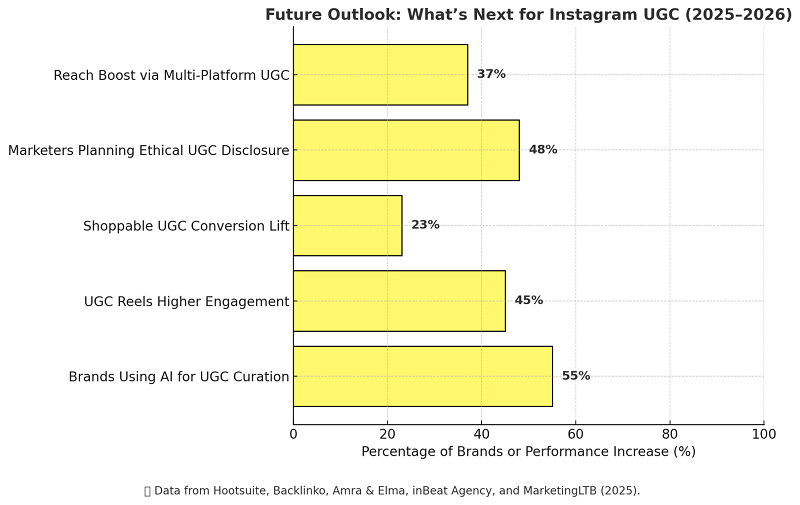
As Instagram continues to evolve, the future of user-generated content (UGC) in 2025 and beyond is expected to be shaped by technology, regulation, and deeper personalization.
The next stage of UGC growth will not simply rely on user participation, but on how intelligently brands can integrate, moderate, and personalize content experiences.
Artificial intelligence is increasingly being used to filter, enhance, and personalize UGC at scale. According to Hootsuite’s 2025 Social Media Trends Report, over 55 percent of brands have already implemented AI tools to automate UGC discovery or visual enhancement.
These tools identify relevant hashtags, analyze tone, and even generate captions that align with brand voice while maintaining authenticity.
Short-form video remains dominant. Data from Backlinko (2025) shows that Instagram Reels containing UGC achieve 45 percent higher engagement than non-UGC Reels. Brands are expected to double down on community-created Reels, tutorials, and story integrations that highlight authentic experiences.
UGC is becoming a direct sales driver. Amra & Elma (2025) found that when brands integrate shoppable UGC into their Instagram Shops or websites, click-through rates increase by 35 percent and conversion rates by 23 percent. The blending of community content and commerce is turning engagement into measurable revenue.
Transparency is becoming essential for trust. Following global discussions on digital authenticity, inBeat Agency (2025) reports that 48 percent of marketers are planning to add clear disclosure labels and user consent notices in all UGC campaigns by 2026. Ethical use of user content will define the next phase of brand-consumer relationships.
UGC will no longer be confined to Instagram. Brands are increasingly repurposing UGC across platforms like TikTok, YouTube Shorts, and Pinterest. MarketingLTB (2025) found that brands using a multi-platform UGC strategy experience an average 37 percent increase in reach and 25 percent better audience retention.
In summary, UGC on Instagram is entering a new maturity phase. The next generation of brand growth will depend not just on how much content users create, but on how responsibly and intelligently brands curate, authenticate, and amplify it.
Sources
- Hootsuite — Social Media Trends Report 2025
- Backlinko — UGC Marketing Statistics 2025
- Amra & Elma — User-Generated Content Statistics 2025
- inBeat Agency — 50 UGC Statistics for 2025
- MarketingLTB — 70+ UGC Statistics 2025
Conclusion
By 2025, Instagram has evolved into a community-powered ecosystem where user-generated content (UGC) drives engagement, authenticity, and measurable business growth.
What began as a creative extension of brand storytelling has now become one of the most effective performance channels in digital marketing.
The data from 2025 confirms this transformation. According to Backlinko, over 93 percent of marketers report that UGC outperforms branded content in engagement and trust metrics.
Amra & Elma found that UGC campaigns deliver a 29 percent higher conversion rate, while MarketingLTB reports up to 70 percent higher engagement compared to traditional content.
These numbers demonstrate that real customer voices and community experiences are now the true engine of influence on Instagram.
However, growth comes with responsibility. The challenges of 2025—authenticity verification, copyright management, and ethical disclosure highlight the need for better frameworks around transparency and AI integration.
Hootsuite’s 2025 Social Trends Report shows that more than 48 percent of brands are planning to introduce UGC labeling, moderation standards, and AI-assisted authenticity checks by 2026.
The future of Instagram UGC lies in balance: automation and authenticity, efficiency and ethics, technology and trust. The brands that will thrive are those that treat UGC not as disposable content but as a collaborative relationship with their audience.
In 2025 and beyond, user-generated content is no longer a marketing tactic. It is the foundation of brand identity, community connection, and digital trust.
